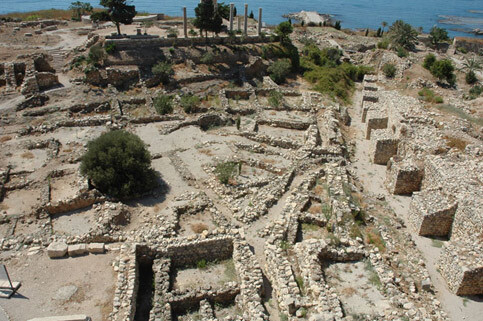United Nations Educational, Scientific and Cultural Organization (UNESCO) 18 September 2006

Archeological site at the foot of the Fort of Byblos. (UNESCO/Studionada)
Experts sent to Lebanon by UNESCO to assess the state of the country’s cultural heritage sites have called for urgent measures to clean up the oil spill from the World Heritage edifices along the Byblos shore line. However, they found that major components of Lebanon’s cultural heritage had been spared by the recent conflict. The experts’ findings were presented at a press conference at UNESCO this morning by the Organization’s Assistant Director-General for Culture, Francoise Riviere, and Mounir Bouchenaki, Director-General of the International Centre for the Study of the Preservation and Restoration of Cultural Property (ICCROM), who led the mission, 10 - 15 September.
Despite the limited extent of war damage to cultural heritage, the mission found several areas that require attention to safeguard and revitalize that heritage.
The most serious damage resulting from the conflict concerns the World Heritage site of Byblos, which was affected by the oil spill from the fuel tanks of the Jiyeh power plant, an ecological problem for a large area of the eastern Mediterranean, according to Mr Bouchenaki. He drew attention to the urgent need to clean, manually, the stones at the base of the port’s two Medieval towers and other sea-shore archaeological remains. He estimated that it would take 25 people eight to ten weeks to conduct the operation and said that they would undergo a one-week training period before starting. Mr Bouchenaki estimated the cost of the operation at some US$ 100,000.
The main features of the World Heritage site of Tyre, the Roman hippodrome and triumphal arch, did not sustain any damage, said Mr Bouchenaki. But frescoes in a Roman tomb on the site had come partly unstuck, probably because of vibrations caused by bombs, and required emergency restoration.
The site of Baalbek, inscribed on UNESCO’s World Heritage List, was not damaged by bombs except for the fall of one block of stone, noted Mr Bouchenaki. Fissures on the lintels of the temples of Jupiter and Bacchus at the site had probably widened because of vibrations from bombings nearby and warranted close monitoring, he said. The mission also noted that the souk and some old houses in the Old City of Baalbek, not part of the property inscribed on the World Heritage List, were damaged by bombs.
South of Baalbek, the World Heritage site of Anjar with its Umayyad vestiges was found to have been undamaged but is in a poor state of conservation.
The mission also visited the Old City of Saida and the nearby Temple of Echmoun, which Lebanon is preparing to propose for inscription on the List by the World Heritage Committee, and found them to have been spared by the war.
Mr Bouchenaki outlined more longer-term measures to preserve Lebanon’s cultural heritage: Setting up photogrammetric equipment to monitor fissures in several sites; helping Lebanon’s Department of Antiquities develop its human resources to improve the safeguarding and management of cultural heritage sites; drawing up of a risk map identifying cultural properties with serious structural weaknesses; and undertaking measures to consolidate the most seriously threatened structures.
UNESCO’s Assistant Director-General for Culture stressed the importance of culture as a cement of social cohesion in Lebanon and spoke of the importance of cultural heritage as a symbol of the country’s diversity and tolerance.
Ms Riviere spoke of UNESCO’s efforts, even during the fighting, to draw the belligerents’ attention to their obligation to spare cultural heritage protected by The Hague Convention for the Protection of Cultural Property in the Event of Armed Conflict, of which both Lebanon and Israel are States Parties.
Ms Riviere also announced that some US $70,000 could be made available by the World Heritage Fund for emergency measures for Lebanon’s cultural heritage. This would serve as seed money, she said, and more funds would be raised to help the country revitalize its cultural sector.
UNESCO is also preparing to send another, multidisciplinary mission to Lebanon to assess ways in which the Organization may contribute to reconstruction in culture, education, science and communication, in the framework of the United Nations’ plan for Lebanon.
Related Links